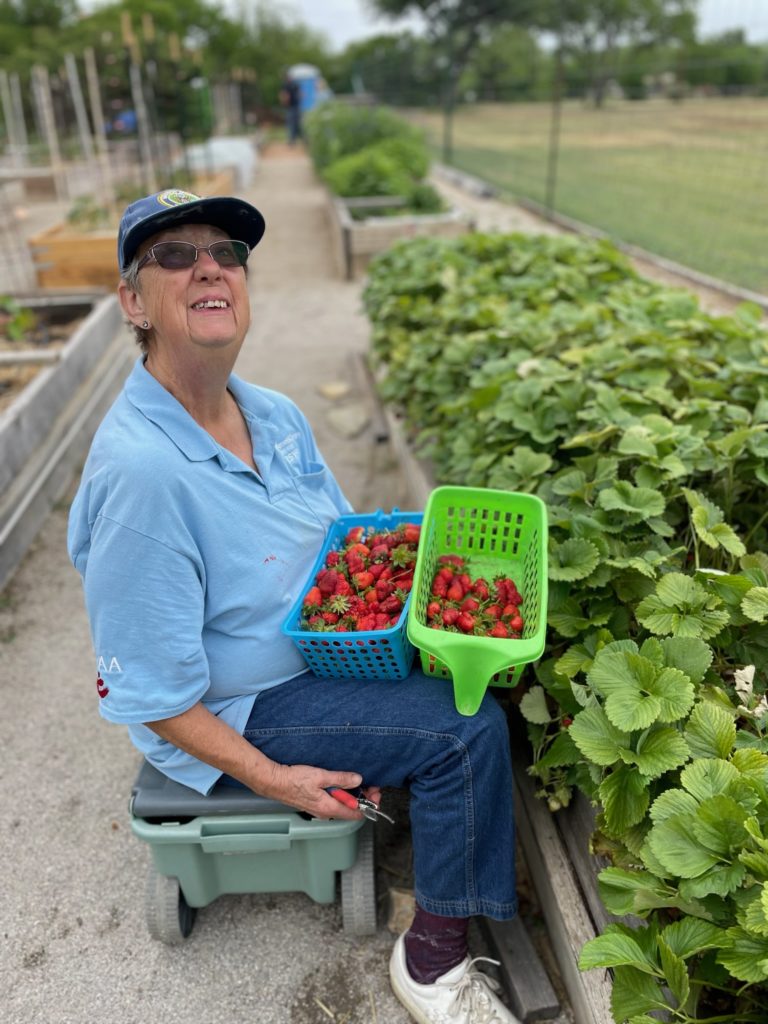
There has been a whirlwind of activity at BCG this month, and the time we looked forward to all winter, as we tended to the soil, is now upon us. The temperatures seem to have warmed just enough to start planting our summer crops. We squeezed in time to continue harvesting some asparagus and strawberries, but our main task this month has been to plant our summer crops and get them established before the Texas summer heat really kicks in.
On the pantry side of the garden, we stick to the basics when it comes to what we grow- vegetables that seem to be the most popular here in Texas. Peppers are always in demand. This year we planted poblanos, two types of bells, and to spice things up a bit, three types of jalapeños. Along with those, a couple other exciting varieties were also added. We’re hopeful they’ll be a hit. Tomatoes, both red and green, are also a favorite. Between the pantry and the personal sides of the garden, there are at least fourteen different varieties of tomatoes that have been planted this year, and we’re anxious to see which are the best producers, best tasting, etc. Other summer crops include four types of green beans (well one of them is actually purple), cucumbers in all sizes from small pickling cucumbers to long, bitterless Armenian cucumbers, lemon squash, and dark star zucchini. By the middle of the month, onions started bulbing, and in a month or so will be ready to harvest. By then summer should be heating up, and heat loving okra will take their place. Finally, in the orchard blackberries are blooming, and we anxiously await their first year of production.
We’ve had a little over two frantic weeks of planting, and now comes the really hard part for us, fighting off the diseases and pests. Although those baby birds look so cute right now cuddled up in their nest in our plum tree, the adult birds darting into the strawberry beds for a tasty treat don’t look quite so cute. We continued researching control methods for the dreaded vine borers and squash bugs that have cut squash production for the last several years. Another organic control method will be added this year to those already used, and we hope to win that battle once and for all. Of course, we have that same dream each year at this time.
While we have not seen any monarch butterflies yet, the perennials in those beds are showing signs of waking up from their winter sleep. Salvias, yarrow, pincushion flowers and milkweed are all in bloom. Buds on the zinnias that were planted earlier in the month are ready to burst open, while Gregg’s Mistflower, a monarch magnet but invasive plant for us, quietly creeps along trying to invade every inch of those beds unnoticed. The monarchs, and other butterflies as well, will be thrilled for whatever space this plant managed to take over when it actually does begin to bloom.
Most of the newly constructed garden beds have now been filled, and we are looking forward to welcoming new gardeners to our garden community. Perhaps they will add yet another type of tomato plant to our already abundant selection.
An outreach event took place April 15th in an effort to bring awareness to the community about various volunteer opportunities. Several people signed up, and at least one of those has already shown up several days to volunteer.
Although irrigation has been an ongoing concern, it’s been a learning process as well. Water is crucial to the success of the garden, and when there are issues with it, immediate action is taken- although possibly not an immediate solution. Is it the power source, the pump, the batteries, the timers, the solar, or something else we’re not even aware of? The system is now up and running, a very good thing, as our new plants are needing a healthy start to what we hope will be a long and productive summer of growing and giving.
[Wrriten by Jan Green]